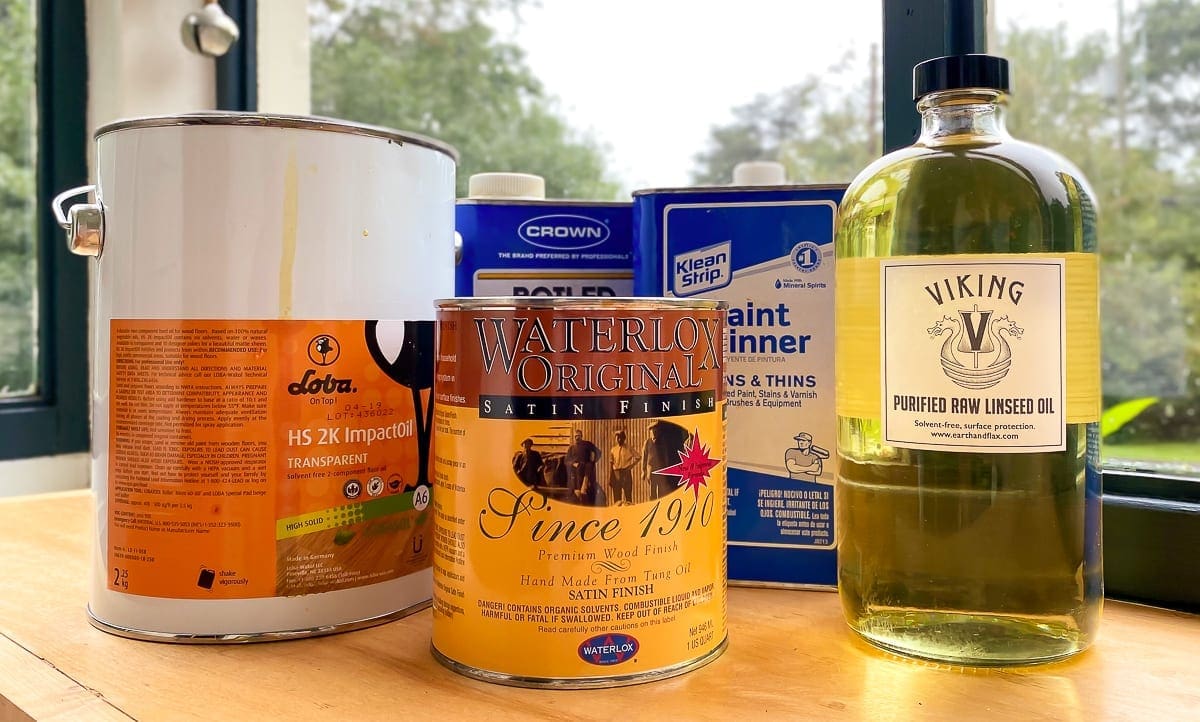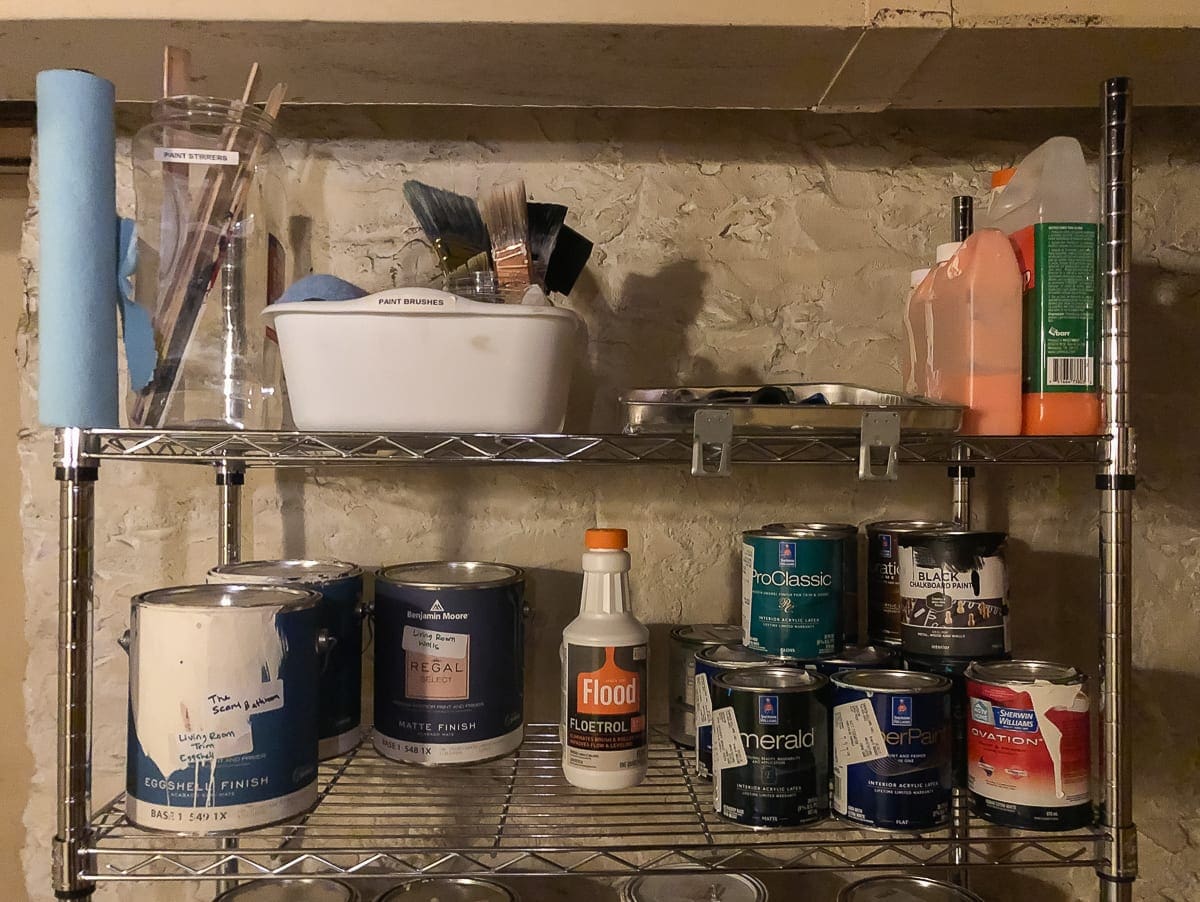Lately, the topic of spontaneous combustion has been coming up in my direct messages and also just generally in my social media feeds. I actually read excerpts of this article on the latest episode of True Tales From Old Houses. So, if you listened to that episode, this will all sound very familiar. However, I wanted to write a companion blog article to offer a little more about the science of spontaneous combustion and some commonly used products that are combustible. I also wanted to put some instructions for rag disposal in print so you can refer to them as often as you need.
Spontaneous combustion is probably coming up more often because it’s summer, and many of us are using more solvents, stains, paints, that type of thing. As DIYers, most of us tend to use many different products to finish our projects, and the shelves in our storage areas are getting full.
What is Spontaneous Combustion?
The term spontaneous combustion gets tossed around as a warning, but what does it mean? Is it really a safety risk? The short answer is, of course, yes.
First, Many people confuse the term flammable with combustible. Most of us know that gasoline is flammable. However, my favorite sneakers are also flammable if I set them on fire. Spilled oil? Of course, it’s flammable. We learned that in elementary school. But a peach pie that stays too long in the oven is also flammable. If the conditions are right and something will burn, it is flammable.

When we talk about something being combustible, that’s different. Basically, if the conditions are right, a combustible substance or rags covered in a combustible substance can set themselves on fire–no matches or hot oven required.
The Science of Combustion
A combustible substance reacts with oxygen, which is called oxidization. Combustible reactions are rapid chemical reactions, and they create a lot of heat.
I’ll give you a real-life example. Let’s say that you’ve just stained some woodwork. You applied the stain with rags, and you wiped off the excess the same way. Then, you took those stain-soaked rags and tossed them in a pile in your garage or basement.
Fire needs heat, oxygen, and fuel to burn. Combustibles, such as wood stain, create their own heat via oxidization as they dry.
The other two components necessary for a proper fire are everywhere. Oxygen? Hello, breathing, and as we discussed earlier, many things are flammable and serve as fuel.
So, back to your pile of stain-covered rags. The heat is building up in that pile as the stain dries, and that heat cannot dissipate. It has nowhere to go. It’s stuck there in the center in that wad of rags. That heat caused by the chemical reaction can build and build until it finally ignites the whole pile. Once it ignites, the rest is history.
At best, you have a small, scary fire that you catch right away. At worst, well, picture all of the explosive and flammable products you might keep in a shed, outbuilding, or in the basement. If that’s where your rags ignite, the problem has just gone from bad to destructive and possibly deadly.
That is why it is so important to dispose of your rags covered in combustible substances properly.
Great. Now, you know, but how do you do that?
How to Safely Dispose of Rags Used with Combustible Products
I live in a damp and humid climate in the summer, and it’s snowy in the winter. So I lay my used rags out flat in the yard, far away from each other and nowhere close to anything else that might burn. I weigh the rags down with a rock to keep them from blowing into each other or towards any structures.

Once those rags are dry, I gather them and toss them in a plastic or metal bin with a tight-fitting lid to cut off any additional oxygen. Then, I get rid of it all at my local household hazardous waste collection site. Some trash services allow a small amount of this carefully packaged waste, but mine does not. It’s terrible for the landfill anyway.
If you live in a dry climate or your area is experiencing a sustained period of dry weather, do not risk laying the rags out flat to dry. Let me repeat: Do not risk it. You do not want to be ground zero for a wildfire.
Instead, Immediately place the used rags in an empty metal paint can or heavy-duty plastic bin. Cover them with water and add a squirt or two of an oil-dissolving soap like Dawn dish soap. Finally, tightly cover the container with a lid and take the whole thing to your household hazardous waste center.

Some Common Combustible Products
Many DIYers already know that wood stain is combustible, and finding out that paint thinner is combustible is probably no surprise. However, other “safe” items like high-quality purified linseed oil, Waterlox, Loba Impact oil, and even my beloved Rubio Monocoat carry the same warning. Most of the penetrating oil-based sealers, paints, and polyurethanes are also combustible. Read your labels carefully. Products produced outside the USA often state they are “self-igniting,” which is the same thing.

Some DIY articles encourage readers to dispose of rags properly to avoid spontaneous combustion, but some do not. This is especially true on Instagram, where the finished product is in focus and safety may be assumed. So whether there is a disclaimer or not, please take spontaneous combustion seriously.
Always read the safety warning labels to determine if the product you are using is combustible, and act accordingly.
I hope this post was helpful, and please let me know if you have any questions.

Many thanks to my sister, Erica, for proofing the science in this article. She’s a long-time science and chemistry teacher.





8 Comments
Downraspberrylane
Thank you for this!
Stacy
You’re welcome!
Sarah
The historic home next to us burned for 7+ hours in 2019 thanks to poly rags left in the kitchen by a sub contractor. Thank goodness the house was empty and under renovation. Our house almost went up in flames thanks to a shared tree line. One of the most traumatic things I’ve ever experienced. The good news our house was fine, and the neighboring home has been beautifully restored. I heard at the time from FIVE PEOPLE who knew of homes that had burned down due to this same issue. So important to share with people – thank you so much.
Stacy
Oh my goodness! You’ve experienced your share of these traumatic and preventable disasters with combustibles. I appreciate your comment, and I am so glad your house was spared.
Jenny
A great article and a great reminder for all of us. A coworker of mine had her house burn down a few years ago due to spontaneous combustion of oily rags in her garage. Her sons were on the high school shooting team at the time and ammunition was stored in the garage as well, so she said it was pretty scary. Thankfully all the people and pets were okay, but it was a traumatic and expensive experience for their family. They lost most of their house, a large portion of their belongings due to smoke and water damage, their garage, and at least one car.
Stacy
Oh goodness! That does sound scary. I’m glad the people and pets were ok. <3
SBK
So important! Five years ago, our dear friends lost their home (and it destroyed their neighbor’s home) because poly-soaked rags left outside combusted (they were having their floors redone).
https://swampscott.wickedlocal.com/news/20160703/five-alarm-fire-takes-down-bay-view-drive-homes
Stacy
That is so sad and terrifying!